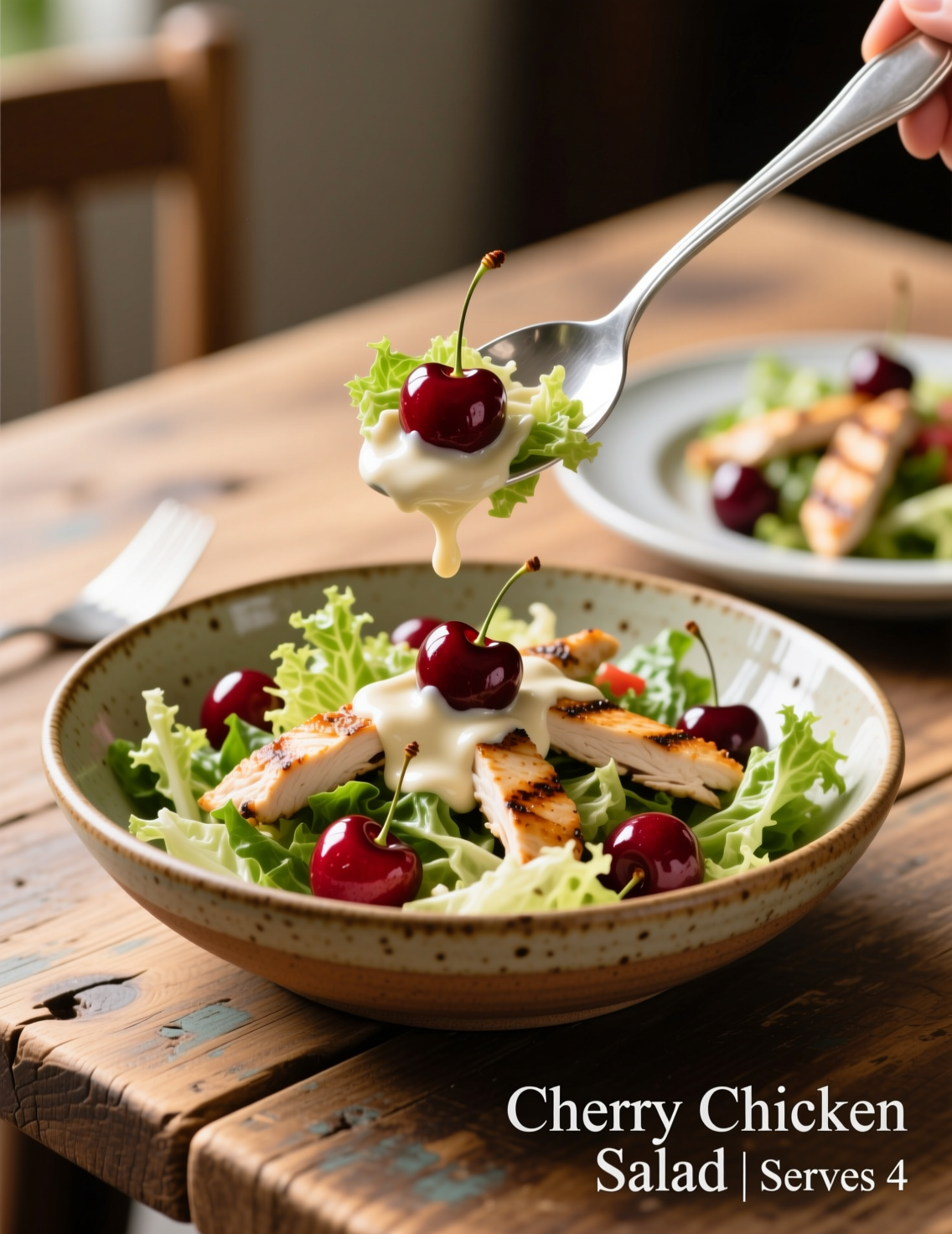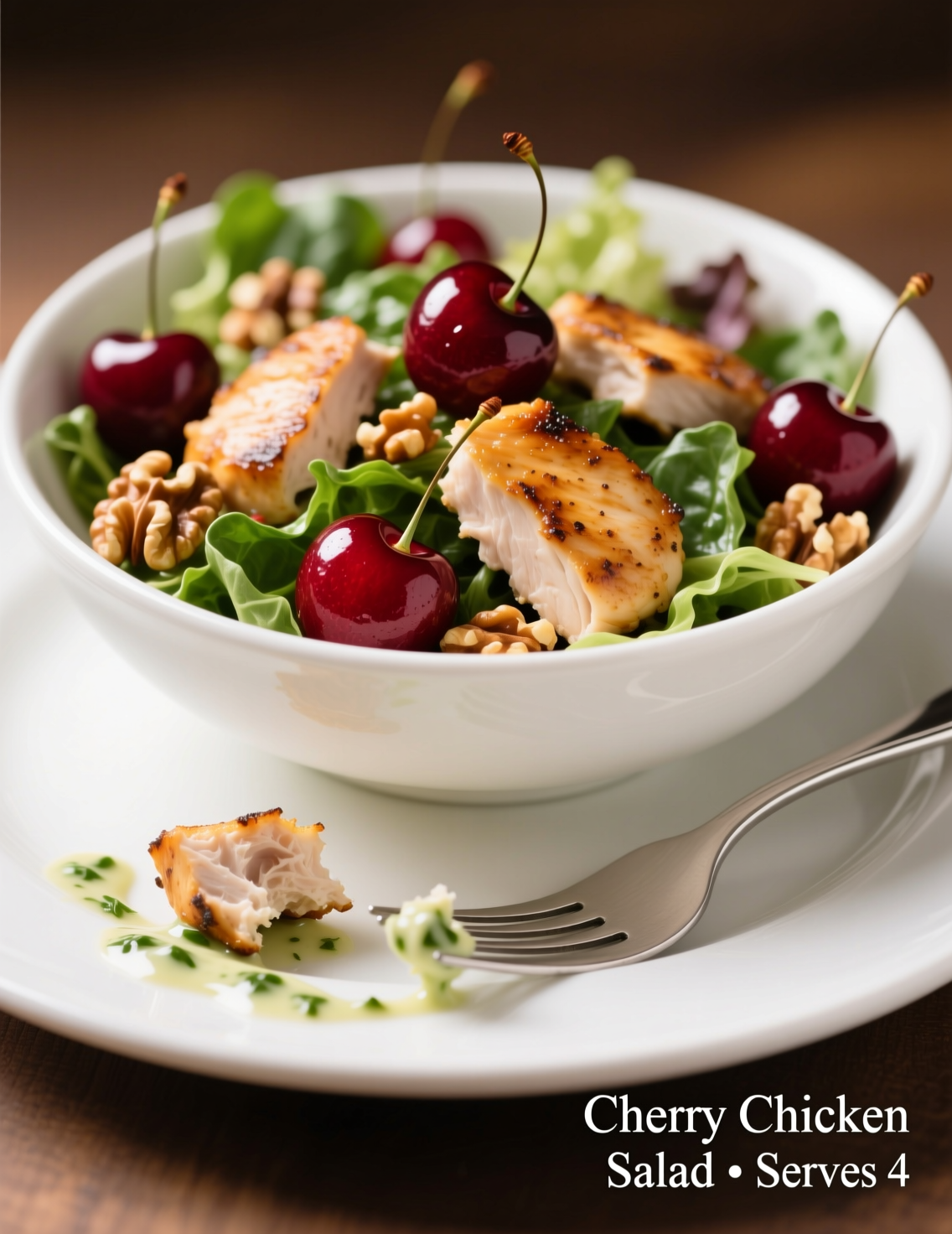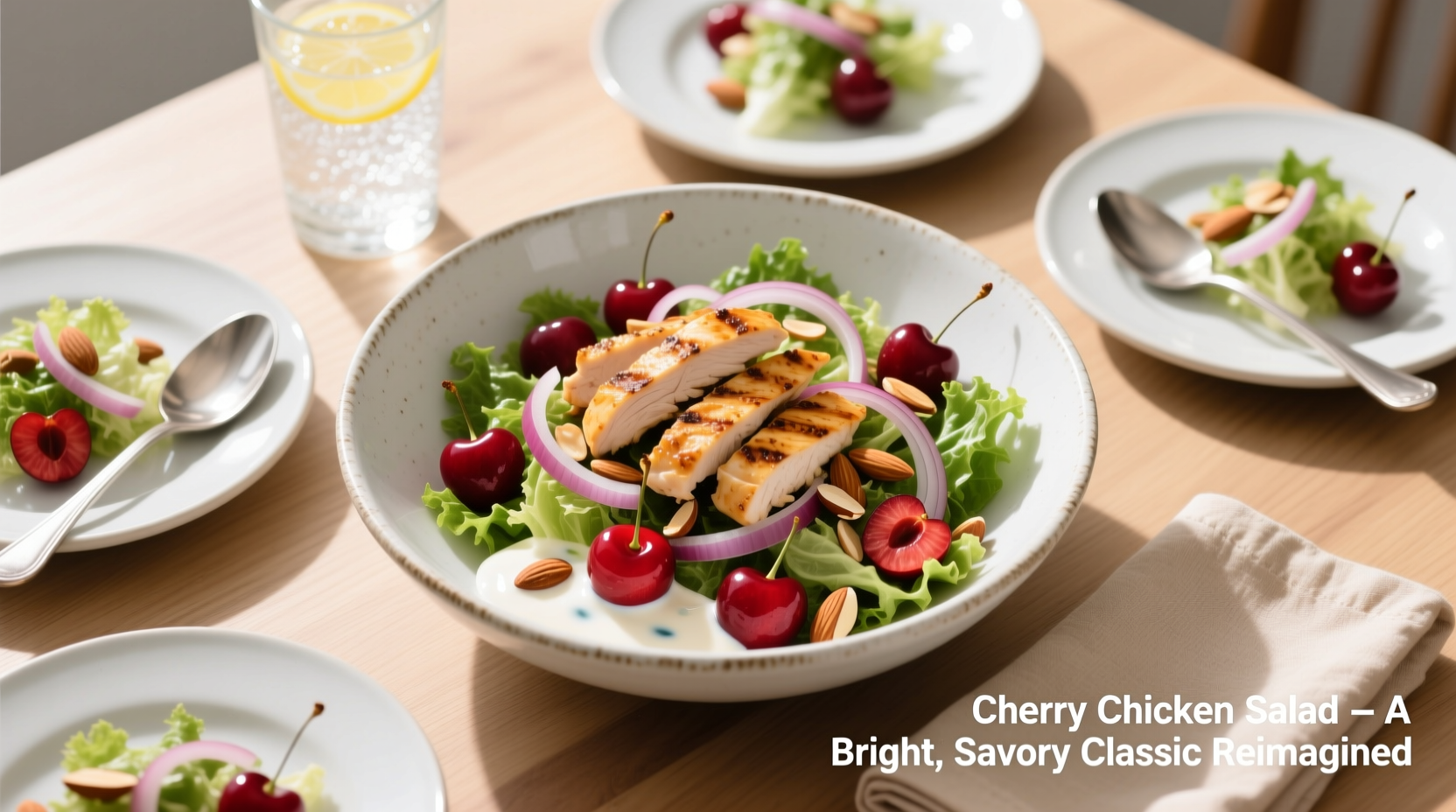Chicken salad has worn many faces over the years, from the mayo-heavy cafeteria staple to the light and vibrant modern spins you’ll see at cafés. But there’s one version that consistently stands out—cherry chicken salad. Sweet cherries paired with tender chicken create a dish that surprises even seasoned cooks. You’re not just eating a salad here; you’re balancing contrasting flavors in a way that feels both refreshing and hearty. This article will take you through an expert-level understanding of making cherry chicken salad for four servings. It’s not just a recipe—it’s about technique, flavor science, and the art of execution.
Why Cherry Chicken Salad Matters
Cherry chicken salad isn’t some trendy invention, it’s been quietly sitting in cookbooks and on picnic tables for decades. But professionals know why it matters—it’s a study in contrast. You’ve got protein-rich chicken, slightly nutty textures if you add almonds or pecans, creamy dressing that carries it all, and those cherries. Cherries are the bridge. They deliver acidity, sweetness, and color in one bite.
Researchers in food pairing have long emphasized the role of contrasting taste profiles. Studies published in the journal Flavour show that foods sharing volatile compounds often taste harmonious, but opposite notes—sweet meeting savory, tart meeting fatty—can create excitement in the mouth. That’s exactly what cherries do here. They don’t fight the chicken; they elevate it.
Ingredients and the Professional Lens
When cooking for four, balance is key. Professionals don’t just dump ingredients together. Every piece must play a role. Here’s a breakdown of the classic cherry chicken salad recipe tailored for 4 servings.
Ingredients:
- 2 cups cooked chicken breast, cubed or shredded
- 1 cup fresh cherries, pitted and halved (or dried cherries if not in season)
- ½ cup celery, finely chopped
- ½ cup red grapes, halved (optional but adds round sweetness)
- ⅓ cup toasted pecans or almonds, roughly chopped
- ½ cup mayonnaise or Greek yogurt (or a mix)
- 1 tsp Dijon mustard
- 1 tbsp fresh lemon juice
- ½ tsp salt
- ¼ tsp black pepper
- Lettuce leaves or croissants for serving
This set feeds four comfortably. It’s easy to scale up for service in a bistro or catering event. Substitutions should be deliberate. For example, dried cherries work well, but reduce the dressing sweetness to avoid an overly sugary profile. Greek yogurt adds tang, but mayo maintains that classic creamy cling.

Technique Over Recipe
Cooking pros know a recipe is only as strong as its execution. Let’s talk technique. Chicken must be moist, not stringy. Poaching chicken breasts in lightly salted water with aromatics (onion, bay leaf, peppercorns) ensures tender, juicy meat. Over-roasted chicken dries out, leaving the salad flat and mealy.
Cherries demand care too. If you’re using fresh cherries, don’t slice them too early. Their juice bleeds into the mix, tinting everything pale pink. That may sound pretty but it muddies flavors. Pit and halve them right before mixing. If dried cherries are the option, soak them in warm water or a splash of white wine to plump them back up—lazy cooks skip this and end up with chewy nuggets that don’t blend in.
Toasting nuts? Always. Raw nuts in salad taste unfinished. A light toast in a dry pan brings oils to the surface, boosting aroma and crunch. This tiny step separates a chef’s plate from a rushed home version.
Building the Dressing
The dressing makes or breaks this salad. Mayo is traditional but can feel heavy. Yogurt cuts through with acidity. A hybrid approach works wonders: 3 parts mayo, 1 part Greek yogurt. Dijon mustard adds depth without dominating. Lemon juice isn’t optional; it sharpens flavors and prevents the salad from falling flat.
The dressing should cling, not drown. A ratio of about ¼ cup dressing per cup of chicken mix is a good guideline. Professionals often reserve a spoonful of dressing, mixing it in last if needed after tasting. This ensures the balance remains on the salad’s side, not the sauce’s.
Textural Play in Professional Kitchens
Every good salad is about texture. Too much cream, and you’ve got mush. Too many crisp bits, and it feels raw. The cherries provide bursts of juiciness. Celery adds crunch. Nuts bring structure. Chicken is the soft, neutral canvas tying it together.
Texture matters more than people think. The human brain actually perceives food as tastier when there’s contrast. According to research from Cornell University, crunch triggers more sensory signals, making the eating experience more memorable. A chef plating cherry chicken salad in a restaurant isn’t just thinking about taste—they’re designing a textural experience.
Variations That Professionals Experiment With
No dish stays static. Cherry chicken salad has many interpretations. Professionals often push its boundaries.
- Herbal Depth: Fresh tarragon, dill, or parsley can give it a garden-fresh finish. Tarragon with cherries is bold but it works—slight anise against sweetness.
- Spice Edge: A pinch of curry powder or smoked paprika in the dressing adds warmth. Trend-forward cafés in New York have leaned into this fusion approach.
- Grain Bowl Base: Instead of serving on lettuce or bread, spoon it over farro or quinoa. This turns it from salad into a hearty lunch bowl.
- Luxury Touch: Some chefs fold in goat cheese crumbles or brie. Creamy tang against cherries and chicken is indulgent.
These variations matter because modern eaters crave novelty. A 2023 Mintel report found that 67% of consumers are interested in trying “unexpected pairings” in familiar dishes. Cherry chicken salad is ripe for reinvention.
Common Mistakes Cooks Make
Let’s be blunt—people ruin this salad often. They cut corners. Here are mistakes pros avoid.
- Overdressing: Too much mayo smothers everything. The salad should breathe.
- Skipping Acidity: Lemon juice or vinegar is essential. Without it, the salad tastes flat.
- Poor Chicken Prep: Dry, overcooked chicken makes every bite disappointing. Moisture is non-negotiable.
- Uneven Cuts: Uniform cuts matter. If cherries are giant and celery tiny, the mouthfeel is unbalanced.
Correcting these is simple but critical. Professional cooks obsess over the details because that’s what guests remember.

Service and Presentation
For 4 servings, presentation matters, even at home. You don’t dump salad in a bowl and call it done. Professionals think about color, layering, and vessel.
For casual serving, spoon into butter croissants—the sweetness of pastry complements cherries beautifully. For plated service, layer butter lettuce leaves, mound salad in the center, scatter extra halved cherries around, and dust with cracked black pepper. The red, green, and creamy tones pop on a white plate.
In catering, salad can be portioned into small endive leaves as handheld bites. Guests love the neatness, and the cherry halves glisten like jewels.
Nutrition and Professional Considerations
Cherry chicken salad is surprisingly balanced. Chicken breast delivers lean protein. Cherries supply antioxidants like anthocyanins, which reduce inflammation. Nuts provide healthy fats. Using Greek yogurt in place of some mayo cuts calories and adds probiotics.
A serving typically runs around 350–400 calories depending on dressing ratio and nut choice. For a chef designing menus, this makes it a smart lunch or light dinner option. It’s filling but not heavy, indulgent yet balanced.
Dietary adjustments are straightforward. Gluten-free guests? Serve it in lettuce wraps. Dairy-free? Skip yogurt, lean into olive oil–based mayo. Keto? Drop the grapes and cherries, use raspberries instead. A good professional adapts while protecting flavor integrity.
The Bigger Picture: Trends and Relevance
Cherry chicken salad fits neatly into current culinary trends. Seasonal eating? Check—cherries peak in summer. Healthy but indulgent? Yes—it balances creaminess and freshness. Portable and versatile? Absolutely—works as a sandwich filling, bowl topping, or stand-alone plate.
Food culture in 2025 leans toward “familiar but twisted.” Consumers want classics but with surprises. That’s why this recipe stays relevant. You can see it on brunch menus, wedding buffets, or as part of a gourmet meal-prep service. Its adaptability makes it a professional’s quiet weapon.
Final Thoughts and Expert Advice
Cherry chicken salad may look simple, but it teaches lessons about balance, precision, and creativity. Sweet meets savory, crunchy meets creamy, classic meets modern. For four servings, it’s straightforward to make, but the deeper you go, the more you see its layers.
As an expert, here’s the recommendation: don’t just follow the recipe. Taste constantly, adjust boldly, and think about texture as much as flavor. Use the best cherries you can find, treat chicken with respect, and toast your nuts without fail. Professionals aren’t magicians—they’re detail-keepers.
Make this dish, and you’ll see why chefs love it. The cherries sing, the chicken grounds, and the whole bowl feels more alive than a salad has any right to.
FAQs
How many people does this cherry chicken salad recipe serve?
It’s designed to serve 4 people comfortably.
Can I use dried cherries instead of fresh?
Yes, but soak them in warm water or wine to soften first.
What’s the best way to cook chicken for this salad?
Poach gently in salted water with aromatics for tender results.
Is mayonnaise necessary in the dressing?
No, you can mix with Greek yogurt or even use all yogurt for a lighter option.
Can I make cherry chicken salad ahead of time?
Yes, but add the cherries and nuts just before serving to keep them fresh.
What nuts work best in this recipe?
Toasted pecans or almonds are the most balanced choices.
How should I serve this salad?
It works well in croissants, lettuce wraps, or plated over greens.
Is this salad healthy?
Yes, it’s rich in protein, antioxidants, and healthy fats, especially if yogurt replaces some mayo.
Can I make it dairy-free?
Yes, use dairy-free mayo and skip the yogurt.
What’s the biggest mistake to avoid?
Overdressing—too much sauce overwhelms the flavors.

Mariana is a passionate home cook who creates delicious, easy-to-follow recipes for busy people. From energizing breakfasts to satisfying dinners and indulgent desserts, her dishes are designed to fuel both your body and hustle.
When she’s not in the kitchen, she’s exploring new flavors and dreaming up her next recipe to share with the Foodie Hustle community.

